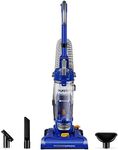Buying Guide for the Best Upright Vacuums
Choosing the right upright vacuum can make cleaning your home much easier and more effective. Upright vacuums are popular for their strong suction and ease of use, especially on carpets and large floor areas. When shopping for one, it's important to think about your specific cleaning needs, the types of floors you have, and any special features that might make your cleaning routine simpler. Understanding the key specifications will help you find a vacuum that fits your lifestyle and keeps your home tidy.Suction PowerSuction power refers to how strongly the vacuum can pull in dirt and debris from your floors. This is important because higher suction means better cleaning, especially for thick carpets or homes with pets. Suction power is often measured in air watts or similar units, but sometimes brands use their own terms. Generally, lower suction is fine for hard floors and light messes, medium suction works well for mixed surfaces, and high suction is best for deep carpets or heavy-duty cleaning. Think about your floor types and how much dirt you usually deal with to decide what level of suction you need.
WeightThe weight of an upright vacuum affects how easy it is to push, carry, and store. Lightweight models are easier to move around, especially if you have stairs or need to carry the vacuum between rooms. Heavier models might offer more power or larger dust bins, but can be harder to maneuver. If you have mobility concerns or a multi-story home, a lighter vacuum may be best. If you mostly clean large, open areas, a heavier model might not be a problem.
Filtration SystemThe filtration system determines how well the vacuum traps dust, allergens, and tiny particles. HEPA filters are the gold standard, capturing very small particles and making them ideal for allergy sufferers or homes with pets. Standard filters are fine for general cleaning if allergies aren't a concern. Some vacuums have washable filters, which can save money over time. If you or your family have allergies or asthma, look for a vacuum with a high-quality filtration system.
Bagged vs. BaglessUpright vacuums come in bagged and bagless designs. Bagged vacuums collect dirt in a disposable bag, which is easy to remove and less messy, but you'll need to buy replacement bags. Bagless vacuums use a dust bin you empty and reuse, which saves money but can be messier to empty. If you want less maintenance and don't mind buying bags, go for a bagged model. If you prefer not to buy bags and don't mind a little extra cleaning, a bagless vacuum might suit you better.
Cord Length and Cordless OptionCord length affects how far you can clean without changing outlets. Longer cords are helpful for large rooms or open spaces, while shorter cords are fine for smaller areas. Some upright vacuums are cordless, running on batteries for more freedom of movement, but they need to be recharged and may have limited run time. If you have a large home or dislike plugging and unplugging, look for a longer cord or consider a cordless model if you prefer convenience and don't mind charging.
Brush Roll and Height AdjustmentThe brush roll is the spinning part that helps lift dirt from carpets. Some vacuums let you turn the brush roll on or off, which is useful for switching between carpets and hard floors. Height adjustment lets you raise or lower the vacuum head for different carpet thicknesses. If you have a mix of floor types, look for a vacuum with adjustable brush roll and height settings to get the best cleaning results everywhere.
Dust Bin or Bag CapacityCapacity refers to how much dirt the vacuum can hold before you need to empty it. Larger capacities mean you can clean more before stopping, which is helpful for big homes or heavy messes. Smaller capacities are fine for quick cleanups or smaller spaces. If you clean often or have a large area to cover, a bigger dust bin or bag will save you time.
Attachments and ToolsAttachments like crevice tools, upholstery brushes, and pet hair tools add versatility to your vacuum. These help you clean furniture, stairs, tight spaces, and more. If you have pets, look for a vacuum with a pet hair tool. If you want to clean above floors or in corners, make sure the vacuum comes with the right attachments for your needs.















